*New critters we’ve seen on our 2009 trip so far: black bears, grizzly bears, elk, fox, wolf, moose, beavers, groundhog, prairie dogs, big horn sheep, buffalo (bison), white tail deer, chipmunks, pronghorn, burros, pika, moose, Uinta ground squirrel, mountain goats, mule deer, longhorn beetle, otters, northern whiptail lizard, jackrabbit, rock squirrels, collared lizard, Kaibab squirrel 
*New birds we’ve seen on our 2009 trip so far: bald eagles, golden eagles, wild turkeys, osprey, western meadowlark, mountain bluebird, sandhill cranes, Canadian geese, American white pelicans, trumpeter swans, killdeer, common merganser, great blue heron, raven, yellow-headed blackbird, Brewer’s blackbird, brown-headed cowbird, double-crested cormorant, Clark’s nutcracker, common goldeneye, white-breasted nuthatch, Steller’s jay, black-chinned hummingbird, Cassin’s finch, Cassin’s kingbird, peregrine falcon, western scrub jay, blue grouse, gray-headed dark-eyed junco, red-tailed hawk
*National Parks/Monuments visited on 2009 trip so far: 27
*State Parks visited on 2009 trip so far: 4
Early Sat. morning we hit the road for the 151 mile drive south to the North Rim of the Grand Canyon (
http://www.nps.gov/grca). On the way we made a quick stop at Pipe Spring National Monument (
www.nps.gov/pisp) located on the Kaibab-Paiute Indian Reservation. The Visitor Center is operated jointly by the National Park Service and the Kaibab-Paiute Tribe and explains the human history of the area over time. We stopped only long enough to get our National Park book stamped and make a quick walk through the museum.

The North Rim is about 1,000 feet higher in elevation than the South Rim and sometimes has been referred to as an oasis in the desert. Only 15 miles “as the raven flies” separates the two, but there is definitely a slower pace to the North Rim, smaller crowds, and a real sense of solitude. There’s only one campg

round on this side of the canyon, amidst the pine trees and aspens, with amazing views. We had requested one of the premier sites, which are closest to the rim, and we were not disappointed with the view. There are no hookups at this campground, but as we’ve mentioned before, that’s not a problem for us, especially for only two nights.
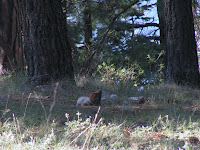
Surrounded by all this beauty, we spotted the rare Kaibab Squirrel also known as the “Silver Ghost of the North Rim”. This squirrel lives
only on the North Rim and nowhere else in the world. It is dark brown or black with a bushy white tail and has tufted ears. Our site was also visited by several gray-headed dark-eyed juncos (a member of the sparrow family), and a family of blue grouse, all simply wandering in the campground looking for food.

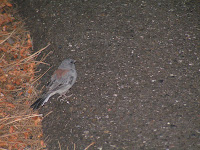

After we managed to get the RV leveled and secured satellite reception, we headed to the back deck of the Grand Canyon Lodge just in time for the condor talk given by NPS volunteer, Nancy Varga. Condors are one of the rarest birds in the world, weighing up to 23 lbs. with a wing span up to 9-1/2 feet and not that long ago there were only 22 left in the world. Condors generally lay one egg every two years, but the captive breeding program found a way to trick the mama bird into laying more. As soon as she drops an egg, a researcher will grab it before she knows it’s gone. She thinks she hasn’t laid an egg and will produce another. Gradually they stretched this experiment to taking the second egg the same way, and she actually produced a third. Thanks to this capti

ve breeding program, there are now 362 condors worldwide, nearly all wearing numbered tags and transmitters. They can soar and glide up to 50 mph and can fly 5,000 - 6,000 feet above the canyon rim. When flying, they can easily be mistaken for turkey vultures, but the condor’s wings are straight and rarely flap unlike the turkey vulture’s whose wings are more v-shaped. Besides showing us an example of a condor egg, Nancy held up a feather from each bird, and you can see how much bigger the condor’s is. Seventy condors fly freely around northern Arizona and southern Utah, and our hope was to see one while at the Grand Canyon.
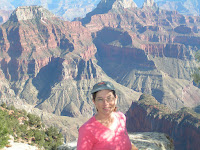
The Bright Angel Point Trail begins behind the lodge and is half mile roundtrip along a paved trail offering spectacular views of one of the side canyons. From a couple vantage points we could see smoke from the still smoldering fires across the canyon that was started by lightning 10 days earlier. Upon our return we wandered through the lodge re-built in 1936 checking out the historical displays, and then we stopped at the Visitor Center to pick up maps, guides, and of course, Jr. Ranger booklets.



The next day we decided to drive to Cape Royal and Point Imperial lookouts. Cape Royal was about 23 miles from the campground to the trailhead, and along the way we passed a number of recently burned areas. In fact, some spots were still smoldering with an occasional flame.

The Cape Royal Trail is .6 miles roundtrip along a tree-lined, paved walkway providing views of the canyon, Angels Window, and the Colorado River as markers along the trail told of the area’s natural history and plant life. Cape Royal Point offered some incredible views though with the smoky haze the colors were not as vibrant.
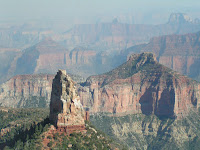
Driving back down the road, we turned right at the junction to drive another 11 miles to Point Imperial, the highest point on either rim at 8,803 feet. We only walked a short portion of this 4 mile trail which afforded us excellent views of Mt. Hayden (at left) and Marble Canyon.
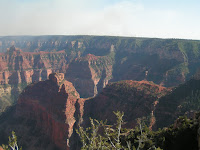
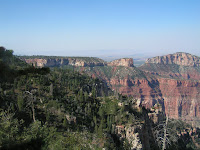

That night we walked out to the rim, sat on a ledge, and watched the sun set across the canyon. What a beautiful sight!
The next day, as we were leaving, just inside the entrance were a couple dozen buffalo grazing in the field. Several people were out of their cars taking pictures, and we think one per

son got a little too close, spooking them, because suddenly they all started running towards the trees. Good thing they didn’t run the other direction...towards the road! We were now heading for a week at the Grand Canyon’s South Rim.

No comments:
Post a Comment